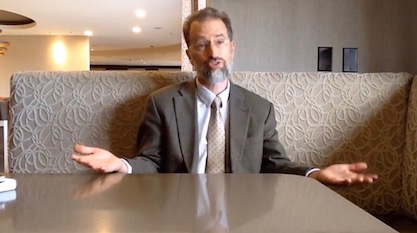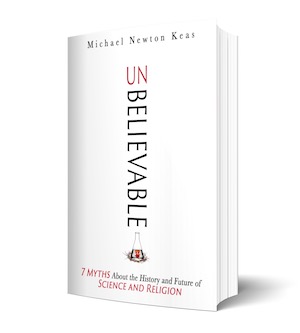 Free Speech
Free Speech
In Unbelievable, Mike Keas Highlights Myths and Realities of Anti-Science Persecution


In Unbelievable: 7 Myths about the History and Future of Science and Religion, officially out today, science historian Mike Keas says that the persecution of science by religion is mostly myth. The medieval “Dark Ages” did not largely consist of the Church squelching science; nor are popular examples of “heretics” like Bruno and Galileo presented fairly by many sources.
The point of Dr. Keas’s book is historical but also very timely: Scientists who challenge materialism today face discrimination as heretics that squelches their research and teaching. And that is no myth.
The Engines of Science
Keas reminds us that the Middle Ages gave rise to one of the engines of science: universities. They provided a good deal of the impetus for the translation of ancient Greek and Arabic works (often about nature) into Latin. Universities were even supported by the Church! He quotes Michael Shank in the book Galileo Goes to Jail: And Other Myths About Science and Religion.
If the medieval church had intended to discourage or suppress science, it certainly made a colossal mistake in tolerating — to say nothing of supporting — the university. In this new institution, Greco-Arabic science and medicine for the first time found a permanent home, one that — with various ups and downs — science has retained to this day. Dozens of universities introduced large numbers of students to Euclidean geometry, optics, the problems of generation and reproduction, the rudiments of astronomy, and arguments for the sphericity of the earth.
And yet who hasn’t heard of a scientist being put to death (that’s Giordano Bruno, by the way, burned at stake in 1600) by Church leaders? Or Galileo being condemned for heresy for presenting his research supporting Copernicus’ views?
Keas examines in detail Bruno’s writings and those of other contemporary thinkers as they discussed the same issues Bruno addressed. What exactly did the Church consider heresy? Keas notes:
Bruno rejected the historic Jesus, the Trinity, as well as other key components of Christian theology. His infamous trial before the Inquisition found him unrepentantly guilty of at least some of these heresies….
Bruno was not a martyr for science. He died chiefly for a series of conventional heresies as well as for a few cleverly reconfigured heresies — some entangled with infinite-worlds ideology that came out of his naturalistic philosophical theology. His habit of mocking and confusing opponents also did not help him avoid the fires of Rome.
A Fresh Look at History
Taking a fresh look at Galileo, Keas again debunks the myth of science versus religion. I’ll just give you a teaser:
Still, [John] Ewing [in his 1809 astronomy textbook] failed to mention how the Jesuits of the Roman College celebrated Galileo’s telescopic discoveries. He also failed to grasp how none of this new knowledge, including the moon-like phases of Venus, conflicted with the geoheliocentric Tychonic system that the Jesuits championed. In this regard Ewing was guilty of the chronological snobbery and pseudo-history that C.S. Lewis later showed comes from avoiding primary sources — “old books.” Many astronomy textbooks since have treated the Galileo affair inaccurately.
In other words, astronomy textbooks for a long time promoted badly researched information about Galileo, who in fact had many friendly relationships with churchmen.
If familiar pop history seems too simple, perhaps it is. Unbelievable sees through the myth and uncovers the real scoop.
The True Source of Repression
It is in our own time that scientific research faces repression — but it’s coming from the scientific establishment, not from religion.

Scientists such as Richard Sternberg and Günter Bechly, Scott Minnich and Eric Hedin, Dean Kenyon and Granville Sewell — they know this well. They challenged materialism, and faced severe pushback, the kind that can ruin your career and reputation.
Biologist Sternberg was demoted from his position as Research Associate at the Smithsonian’s National Museum of Natural History. Paleontologist Bechly, who served as curator at the State Museum of Natural History in Stuttgart, Germany, faced increasing hostility after he made know his views that evolutionary theory had flaws and intelligent design made more sense. He left his prestigious position after finding that the work environment made “productive research and collaboration with colleagues impossible.” Mathematician Sewell found his article critiquing Darwinian evolution in a peer-reviewed publication withdrawn without notice.
The media like to tell a tale that scientific persecution in the Western world is a thing of the past, a relic of a society focused around religion. Examining the evidence and going deeper reveals that the real hostility to open exploration wasn’t from medieval Catholicism. Rather, it’s here and now, from the Darwin lobby.
Why didn’t the medieval Church oppose science? As Keas notes, “[B]elief in the supernatural creation of the cosmos gave humanity solid conceptual ground for expecting to discover mathematically elegant natural laws issued from the maximally rational lawgiver.” Religious believers were correct in their expectation, an awkward truth about history for dogmatic materialists.
Photo: Mike Keas, by Robert Crowther.
